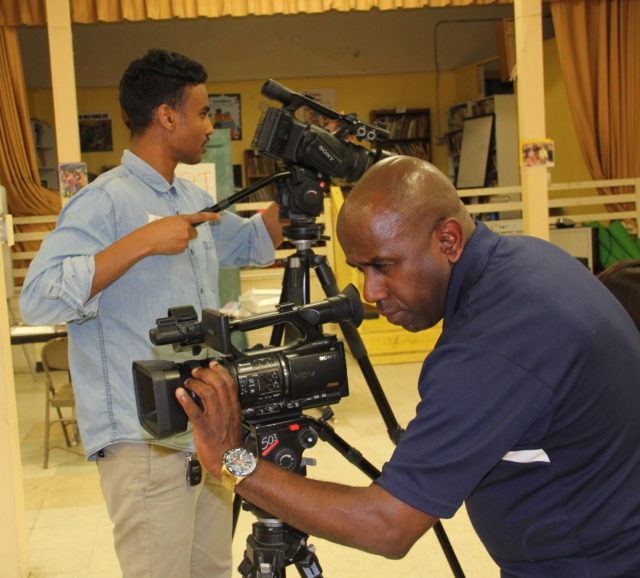NIRV Highlights, Issue 1, August 14, 2017
PDF | Project Details | Other Highlights: Editing and Salsa; NIRVana; Screening NIRV Films

Inspecting cameras for the first time.
The training begins…
Saturday, July 29th marked Day 1 of CSFilm’s New Immigrant and Refugee Visions documentary filmmaking training and production project. Our ten participants met each other for the first time and even before the first session began they were chatting and laughing about parenting, quirky Americanisms and sharing stories of challenges and homelands. No awkward silence here!
As the trainees shared their visions and voices from an incredible diversity of cultures and experiences, the formal introductions brought tears to the eyes of those who contributed so much and worked for years dreaming of this day.
The Shot (heard around the world…)
The training began with an introduction to the art and craft of recording shots – the building blocks of films (or “layers of the production cake”). This included a demonstration of shot types and how shots are gathered to construct a scene – the primary ingredient of stories.
The Mantra: Focus, Expose, Compose and Hold

Michael asks Thelimo and Mubarak about their setup.
When trainees felt overwhelmed by everything that goes into a good shot, Michael introduced his Mantra and the practice of finding your Zen state of mind while shooting, “There is often a lot going on in the world we want to document and we have to stay calm and focused or, instead of usable raw footage, we will end up with unusable raw sewage, so to speak.”
At the end of the first day, each trainee shot a scene of two other trainees playing cards. They had great fun teaching each other games from their own country until it was time to rotate to the camera. Meanwhile, the camera person practiced two parts of the mantra: manual control of focus and holding their shots for at least 7 seconds. “Steady there, stay calm, don’t move… ooohhhmmm.”
On Day 2, Wednesday, the next layer of production technique was added – the impact on the viewer’s experience of camera height, distance from subject and focal length. Does the viewer feel part of or separated from the action? They practiced again, with their now familiar card games.
Compose Yourself

Qin Li and Abdirahman Abdi compose a shot together
On August 5th we began our Saturday morning tradition of screening a portion of a documentary and discussing how its construction impacts our understanding of the story.
The production layer cake got taller with an introduction to the principles of composition. The first weeks’ shooting work was used to review how well their footage met the needs of continuity editing, and to consider the impact of composition on the viewer’s ‘reading’ of the shot. Where should the subject be in
the frame, to the left or right, higher or lower? How can diagonals and use of the fore, mid and background be used to maximize the feeling of depth in the image? “Oh, oh, oh… so many issues that need to become second nature!!! …ooohhhmmm.”
We had hoped to spend the afternoon doing shooting exercises at a nearby outdoor market, but it was cancelled due to morning rain. So we practiced our Mantra in the neighborhood – paying particular attention to the ‘Compose,’ in “Focus, Expose, Compose and Hold.”
And now to the important stuff: FOOOOOOOOOOD!
Of course what everyone is really showing up for is the food! The highlight of the week was a traditional Afghan rice dish that Sayed Hashimi and his wife prepared called Kabuli Pulao – rice with peppers, raisins and delicious spices – with meatballs on the side to accommodate our vegetarian friends. The same day, Qin Li brought a traditional summertime Chinese treat of Green Bean Cakes.
Michael is starting to wonder if the food might be more engaging than the filmmaking! Not so, say the trainees. In their written evaluation of the course thus far, this multi-cultural and multi-generational group from diverse backgrounds had this to say:
Excerpts from Week 1 Program Evaluations:
“People are serious about this project. … Everyone is working hard, and even though we came from different parts of the world, we speak different languages, and have different cultures, we are very comfortable and productive as a team.”
“The lessons I have learned here are above my expectations – the explanations and the way the training is conducted is very exciting.”
“The training is interactive and open to participation by all members. It is not one of those conventional one way approaches to learning.”
“I thought it would be hard to communicate and to be understood. But I was wrong! I feel very understood.”
Photo Gallery: The Training Begins
Click on an image to view all as slideshow.
-

Michael and the film crews outside the CSFilm office. Left to right: Michael, Mubarak, Thelimo, Rafael, Sayed, Katsy.
-

Sayed and Mohammad, looking the part.
-

Katsy, Kiki & Michael observe that Sayed and Mohammed already look like filmmakers as they head down the street.
-

Michael Sheridan reviews various camera functions with the NIRV Trainees
-

Katsy, Kiki & Michael observe that Sayed and Mohammed already look like filmmakers as they head down the street.
-

Qin Li and Abdirahman Abdi compose a shot together
-

Sayed Hashimi of Afghanistan consults on shot with Michael Sheridan. Abdirahman Abdi of Somalia and Braulio Tellez-Vilches of Cuba work side by side. Katsy Rivera-Kientz of Puerto Rico captures Rafael DeLeon of the Dominican Republic and Braulio at cards.
-

Introductions: Kiki, from Ethiopia
-

Qin Li of China practices composition, while Michael Sheridan looks on.
-

Introductions: Braulio, from Cuba
-

Michael asks Thelimo and Mubarak about their setup.
-

Learning to Visualize a Scene
-

Mohammad documents Sayed’s Kubali Pulao for posterity. Qin’s Green Bean Cakes nearly gone. Mubarak asks Sayed about the dish.
-

Sayed checks his notes while Mohammad shoots.
-

Introductions around the table
-

-

-

Braulio and Qin go for the action: baseball practice.
-

Katsy sets up an over-the-shoulder shot during a class exercise
-

Abdi and Rafael embrace teamwork and each other.
-

Abdi and Braulio
-

Braulio Tellez-Vilches of Cuba, Kiki Densamo of Ethiopia and Mohammad Arifuzzaman of Bangladesh inspect their camera for the first time.
-

Introduction to the camera
-

The technology
-

Introductions
-

Thelimo Louis of Haiti sets up a long shot.




You are doing an incredibly useful project. My daughter worked for Maisha, an organization in East Africa, founded by Mira Nair, to teach local folks how to tell their stories using film as a medium. “If we don’t tell our stories, who will?’ is their mantra. What you are doing is exactly like that.
I confirm that is one of the most helpful project for the immigrants in the world.